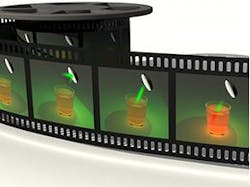2D streak camera operates at up to 100 billion frames per second, images propagating light pulses
A team of biomedical engineers at the Optical Imaging Laboratory of Washington University in St. Louis (St. Louis, MO), led by Lihong Wang, has developed the world’s fastest receive-only 2D camera, a streak camera that can capture events up to 100 billion frames per second.1 "Receive-only" means that it does not require specialized ultrafast-laser active illumination for operation, like other single-shot ultrafast imagers. (the well-known streak-camera setup developed at MIT to image light pulses in flight is not a single-shot imager; it compiles images from many single ultrafast shots over a long period of time to produce a trillion-frame-per-second video.)
Pre-existing receive-only ultrafast imaging techniques have been limited by on-chip storage and electronic readout speed to operations of about 10 million frames per second.
Using a technique they developed called compressed ultrafast photography (CUP), Wang and his colleagues have made movies of the images they took with single laser shots of four physical phenomena: laser pulse reflection, refraction, faster-than light propagation of what is called noninformation (meaning motion that appears faster than the speed of light but cannot convey information), and photon racing in two media.
Wang and his collaborators added components and used algorithms to complement existing streak-camera technology, expanding the view from 1D to 2D. CUP photographs an object with a specialty camera lens, which takes the photons from the object through a tubelike structure to a digital micromirror device (DMD). The micromirrors encode the image and reflect the photons to a beamsplitter, and on to the widened slit of a streak camera.
Sheared photoelectrons convert time to space
Once the raw data are acquired, the actual images are formed on a personal computer; the process is called computational imaging.
“These ultrafast cameras have the potential to greatly enhance our understanding of very fast biological interactions and chemical processes and allow us to build better models of complex, dynamical systems,” says Richard Conroy, PhD, program director of optical imaging at the National Institute of Biomedical Imaging and Bioengineering, part of the National Institutes of Health (NIH). The research was funded by two grants from the NIH.
An immediate application is in biomedicine. One of the resulting movies (see figure at top) reveals a green excitation light pulse moving toward fluorescent molecules where the green changes to red, which is the fluorescence. By tracking this, the researchers can get a single-shot assessment of the fluorescence lifetime, which can be used to detect diseases or reflect cellular environmental conditions like pH or oxygen pressure.
Wang also envisions applications in astronomy and forensics.
Source: http://news.wustl.edu/news/Pages/27744.aspx
REFERENCE:
1. Gao L. et al., Nature (2014); doi:1 0.1038/nature14005

John Wallace | Senior Technical Editor (1998-2022)
John Wallace was with Laser Focus World for nearly 25 years, retiring in late June 2022. He obtained a bachelor's degree in mechanical engineering and physics at Rutgers University and a master's in optical engineering at the University of Rochester. Before becoming an editor, John worked as an engineer at RCA, Exxon, Eastman Kodak, and GCA Corporation.
